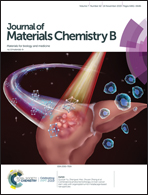Geometrically customizable alginate hydrogel nanofibers for cell culture platforms†
Abstract
The extracellular matrix (ECM) is composed of a hydrogel derived from natural polymers with an anisotropic structure that plays an important role in cell proliferation and differentiation. Alginates—algae-derived polysaccharides—form into the hydrogel, and can be potentially used for the synthesis of cell scaffold materials following the addition of calcium ions. However, to date, the synthesis of anisotropic alginate hydrogels has not been reported. Fibrillization by electrospinning is a simple method used to prepare anisotropic materials. However, it is difficult to fabricate pure alginate nanofibers by electrospinning without adding other polymers. In this study, we exploited the electrospinning method to prepare core–shell fibers in which alginate was encapsulated in the shell of a water-soluble polymer. Anisotropically aligned fibers were obtained with the use of a collector at a high-rotational speed. The gelation of alginate with calcium ions and the following washing process of the shell polymer were carried out and successfully formed pure and aligned alginate fibers. By immobilizing fibronectin on the fabricated alginate fibers and by culturing the cells, it was possible to control cell elongation in the fiber direction. We also successfully prepared a fibrous hydrogel on a wire that was used to construct a conduit-like structure after cells were cultured on it. This material provides a biomimetic cellular microenvironment that can be applied as a three-dimensional platform for cell culture.



 Please wait while we load your content...
Please wait while we load your content...